Streamline Your Life: Understanding How Paperwork Works

Effective paperwork management can seem like a daunting task, but it's crucial for maintaining order in both your personal and professional life. Whether you're organizing financial documents, managing permissions, or simply trying to keep your home office clutter-free, understanding the fundamentals of paperwork can dramatically streamline your daily routines.
Why Paperwork Management Matters

Paperwork isn’t just about organizing papers; it’s about managing information in a way that reduces stress and improves efficiency. Here are some reasons why efficient paperwork management is important:
- Time Management: Efficient organization means less time searching for lost documents and more time being productive.
- Stress Reduction: Clutter-free environments reduce mental clutter and stress.
- Legal Compliance: Proper document handling ensures you’re compliant with legal and financial regulations.
- Improved Relationships: Prompt and organized responses in professional settings can lead to better business relationships.
Understanding Different Types of Paperwork

To manage paperwork effectively, you first need to know what types you deal with:
- Financial Documents: Bank statements, invoices, receipts, tax records.
- Legal Documents: Contracts, permissions, licenses, certificates.
- Business Documents: Meeting notes, business plans, internal memos.
- Personal Documents: Birth certificates, marriage certificates, wills.
The Basics of Effective Paperwork Management

Implementing a system for managing paperwork involves several steps:
1. Sort and Categorize

Begin by sorting all your documents into categories. Here’s how to do it:
- Immediate Action: Documents that require immediate attention or action.
- Short-Term Storage: Documents needed within the next month.
- Long-Term Storage: Items to be kept for longer periods like legal documents.
- Shred or Recycle: Outdated or unnecessary documents.
2. Establish a Filing System

Your filing system can be as simple or as complex as necessary:
- Use labeled folders or binders for each category.
- Color-code folders for easy identification.
- Digital filing for electronic documents.
📁 Note: Clearly label all folders to avoid confusion later on.
3. Implement a Retrieval Process

Make sure you can retrieve any document quickly:
- Alphabetical, chronological, or thematic organization.
- Avoid overstuffing folders; split documents into multiple folders if necessary.
4. Regular Maintenance

Set a schedule for reviewing and organizing your paperwork:
- Weekly or monthly reviews to sort and update documents.
- Set reminders for document expirations or renewals.
5. Digitization and Backup

Consider going paperless where possible:
- Use scanners or smartphone apps to digitize documents.
- Cloud storage for backups ensures your data is safe and accessible.
Implementing a Paperwork Management Plan

Here’s how to put your paperwork management plan into action:
Create a Daily Routine

Develop a habit of dealing with paperwork at a set time each day:
- Morning or evening, spend 15-30 minutes on paperwork.
- This routine prevents the backlog of unfiled documents.
Set Up a Work Area

Your workspace should facilitate efficient paperwork management:
- Dedicated space for incoming and outgoing documents.
- Ensure tools like scissors, staplers, and markers are easily accessible.
Implement Technology

Technology can be a powerful ally:
- Document Management Systems (DMS): Software that helps in organizing and managing documents.
- Task Management Tools: Apps like Asana or Trello can track paperwork-related tasks.
By following these steps, you can develop a comprehensive system for managing your paperwork:
- Assess your documents: Start with a thorough review of what you have.
- Choose your tools: Physical filing systems or digital solutions.
- Implement and refine: Continuously adjust your system based on its performance and your changing needs.
In summary, efficient paperwork management isn't just about tidiness; it's about creating systems that support your life's flow. By organizing, categorizing, digitizing, and maintaining a regular routine, you can reduce stress, save time, and improve your overall productivity. This systematic approach ensures that important documents are accessible when needed, compliance with legal requirements is maintained, and your day-to-day operations run smoothly.
How often should I review my paperwork?

+
It’s advisable to review and update your paperwork at least once a month to manage and clear out any unnecessary documents.
What should I do with outdated documents?

+
Shred documents containing personal information for security. Recycle other paper waste.
Can I manage all paperwork digitally?
+Yes, many documents can be managed digitally, especially financial records. However, some legal documents might require physical copies for official purposes.



